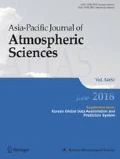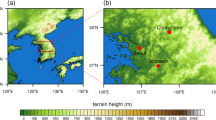Abstract
The raindrop size distribution (RSD) is useful in understanding various precipitation-related processes. Here, we analyze disdrometer data collected in Seoul, South Korea from May 2018 to July 2019 to characterize the RSD according to rain and weather types. Rain types are categorized into stratiform, mixed, and convective rain, and weather types into the Changma front (type CF) and low-pressure system (type L). The slope parameter Λ decreases and the intercept parameter N0 fluctuates with rain rate. Among the rain types, the RSD of stratiform (convective) rain shows the steepest (mildest) slope and the smallest (largest) mean diameter. The logarithm of generalized intercept parameter log10Nw and Λ for stratiform rain have considerably dispersed distributions, which may be attributed to the diversity within the stratiform rain type in Seoul. Mixed-type rain has a larger mean value of log10Nw compared to stratiform and convective rain. Regarding the weather types, the RSD of type CF exhibits a milder slope, a larger mass-weighted mean diameter, and a larger radar reflectivity than type L. These differences between the weather types can be explained by the larger convective proportion in type CF (33%) compared to type L (9%). Possible causes for the differences between the RSD characteristics of the two weather types are examined using reanalysis and satellite data. Type CF has a larger convective available potential energy, a higher cloud top, and more active ice microphysical processes than type L, which can lead to different RSD characteristics.













Similar content being viewed by others
References
Atlas, D., Srivastava, R.C., Sekhon, R.S.: Doppler radar characteristics of precipitation at vertical incidence. Rev. Geophys. 11, 1–35 (1973)
Barthazy, E., Gõke, S., Schefold, R., Hõgl, D.: An optical array instrument for shape and fall velocity measurements of hydrometeors. J. Atmos. Ocean. Technol. 21, 1400–1416 (2004)
Bringi, V.N., Williams, C.R., Thurai, M., May, P.T.: Using dual-polarized radar and dual-frequency profiler for DSD characterization: a case study from Darwin. Australia. J. Atmos. Ocean. Technol. 26, 2107–2122 (2009)
Chen, B., Yang, J., Pu, J.: Statistical characteristics of raindrop size distribution in the Meiyu season observed in eastern China. J. Meteorol. Soc. Jpn. 91, 215–227 (2013)
Chen, B., Hu, Z., Liu, L., Zhang, G.: Raindrop size distribution measurements at 4,500 m on the Tibetan Plateau during TIPEX-III. J. Geophys. Res. Atmos. 122, 11092–11106 (2017)
Chen, Y., Duan, J., An, J., Liu, H.: Raindrop size distribution characteristics for tropical cyclones and Meiyu-Baiu fronts impacting Tokyo, Japan. Atmosphere. 10, 391 (2019)
Copernicus Climate Change Service (C3S): ERA5: Fifth generation of ECMWF atmospheric reanalysis of the global climate. Copernicus Climate Change Service Climate Data Store (CDS). https://cds.climate.copernicus.eu/cdsapp#!/home (accessed 10 December 2019) (2017)
Das, S.K., Konwar, M., Chakravarty, K., Deshpande, S.M.: Raindrop size distribution of different cloud types over the Western Ghats using simultaneous measurements from Micro-Rain Radar and disdrometer. Atmos. Res. 186, 72–82 (2017)
Fernandez-Raga, M., Castro, A., Marcos, E., Palencia, C., Fraile, R.: Weather types and rainfall microstructure in Leon, Spain. Int. J. Climatol. 37, 1834–1842 (2017)
Friedrich, K., Karlina, E.A., Masters, F.J., Lopez, C.R.: Drop-size distributions in thunderstorms measured by optical disdrometers during VORTEX2. Mon. Weather Rev. 141, 1182–1203 (2013)
Ghada, W., Buras, A., Lüpke, M., Schunk, C., Menzel, A.: Rain microstructure parameters vary with large-scale weather conditions in Lausanne, Switzerland. Remote Sens. 10, 811 (2018)
Houze Jr., R.A.: Cloud Dynamics, 2nd edn. Academic Press, Oxford (2014)
Jaffrain, J., Berne, A.: Experimental quantification of the sampling uncertainty associated with measurements from PARSIVEL disdrometers. J. Hydrometeorol. 12, 352–370 (2011)
Janapati, J., Seela, B.K., Lin, P.-L., Wang, P.K., Tseng, C.-H., Reddy, K.K., Hashiguchi, H., Feng, L., Das, S.K., Unnikrishnan, C.K.: Raindrop size distribution characteristics of Indian and Pacific Ocean tropical cyclones observed at India and Taiwan sites. J. Meteorol. Soc. Jpn. 98, 299–317 (2020)
Krajewski, W.F., Kruger, A., Caracciolo, C., Golé, P., Barthes, L., Creutin, J.-D., Delahaye, J.-Y., Nikolopoulos, E.I., Ogden, F., Vinson, J.-P.: DEVEX-disdrometer evaluation experiment: basic results and implications for hydrologic studies. Adv. Water Resour. 29, 311–325 (2006)
Loh, J.L., Lee, D.-I., You, C.-H.: Inter-comparison of DSDs between Jincheon and Miryang at South Korea. Atmos. Res. 227, 52–65 (2019)
Marshall, J.S., Palmer, W.M.: The distribution of raindrops with size. J. Meteorol. 5, 165–166 (1948)
Niu, S., Jia, X., Sang, J., Liu, X., Lu, C., Liu, Y.: Distributions of raindrop sizes and fall velocities in a semiarid plateau climate: convective versus stratiform rains. J. Appl. Meteorol. Climatol. 49, 632–645 (2010)
Pruppacher, H.R., Klett, J.D.: Microphysics of Clouds and Precipitation, 2nd edn. Springer, Dordrecht (2010)
Rha, D.-K., Kwak, C.-H., Suh, M.-S., Hong, Y.: Analysis of the characteristics of precipitation over South Korea in terms of the associated synoptic patterns: a 30 years climatology (1973~2002). J. Korean Earth Sci. Soc. 26, 732–743 (in Korean with English abstract) (2005)
Seela, B.K., Janapati, J., Lin, P.-L., Wang, P.K., Lee, M.-T.: Raindrop size distribution characteristics of summer and winter season rainfall over north Taiwan. J. Geophys. Res. Atmos. 123, 11602–11624 (2018)
Sreekanth, T.S., Varikoden, H., Resmi, E.A., Kumar, G.M.: Classification and seasonal distribution of rain types based on surface and radar observations over a tropical coastal station. Atmos. Res. 218, 90–98 (2019)
Suh, S.-H., You, C.-H., Lee, D.-I.: Climatological characteristics of raindrop size distributions in Busan, Republic of Korea. Hydrol. Earth Syst. Sci. 20, 193–207 (2016)
Sui, C.-H., Tsay, C.-T., Li, X.: Convective-stratiform rainfall separation by cloud content. J. Geophys. Res. Atmos. 112, D14213 (2007)
Testud, J., Oury, S., Black, R.A., Amayenc, P., Dou, X.: The concept of “normalized” distribution to describe raindrop spectra: a tool for cloud physics and cloud remote sensing. J. Appl. Meteorol. 40, 1118–1140 (2001)
Thompson, E.J., Rutledge, S.A., Dolan, B., Thurai, M.: Drop size distributions and radar observations of convective and stratiform rain over the equatorial Indian and west Pacific oceans. J. Atmos. Sci. 72, 4091–4125 (2015)
Thurai, M., Gatlin, P.N., Bringi, V.N.: Separating stratiform and convective rain types based on the drop size distribution characteristics using 2D video disdrometer data. Atmos. Res. 169, 416–423 (2016)
Tokay, A., Short, D.A.: Evidence from tropical raindrop spectra of the origin of rain from stratiform versus convective clouds. J. Appl. Meteorol. 35, 355–371 (1996)
Tokay, A., Wolff, D.B., Petersen, W.A.: Evaluation of the new version of the laser-optical disdrometer, OTT Parsivel2. J. Atmos. Ocean. Technol. 31, 1276–1288 (2014)
Waldvogel, A.: The N0 jump raindrop spectra. J. Atmos. Sci. 31, 1067–1078 (1974)
Wen, L., Zhao, K., Zhang, G., Liu, S., Chen, G.: Impacts of instrument limitations on estimated raindrop size distribution, radar parameters, and model microphysics during Mei-Yu season in East China. J. Atmos. Ocean. Technol. 34, 1021–1037 (2017)
Wen, L., Zhao, K., Wang, M., Zhang, G.: Seasonal variations of observed raindrop size distribution in East China. Adv. Atmos. Sci. 36, 346–362 (2019)
Wu, Z., Zhang, Y., Zhang, L., Lei, H., Xie, Y., Wen, L., Yang, J.: Characteristics of summer season raindrop size distribution in three typical regions of western Pacific. J. Geophys. Res. Atmos. 124, 4054–4073 (2019)
You, C.-H., Lee, D.-I., Jang, M., Kim, H.-K., Kim, J.-H., Kim, K.-E.: Variation of rainrate and radar reflectivity in Busan area and its measurement by cloud types. Asia-Pacific J. Atmos. Sci. 41, 191–200 (2005)
You, C.-H., Lee, D.-I.: Decadal variation in raindrop size distributions in Busan, Korea. Adv. Meteorol. 2015(329327), (2015)
You, C.-H., Lee, D.-I., Kang, M.-Y., Kim, H.-J.: Classification of rain types using drop size distributions and polarimetric radar: case study of a 2014 flooding event in Korea. Atmos. Res. 181, 211–219 (2016)
Yuter, S.E., Kingsmill, D.E., Nance, L.B., Lőffler-Mang, M.: Observations of precipitation size and fall speed characteristics within coexisting rain and wet snow. J. Appl. Meteorol. Climatol. 45, 1450–1464 (2006)
Zhang, G., Xue, M., Cao, Q., Dawson, D.: Diagnosing the intercept parameter for exponential raindrop size distribution based on video disdrometer observations: model development. J. Appl. Meteorol. Climatol. 47, 2983–2992 (2008)
Zhang, H., Zhang, Y., He, H., Xie, Y., Zeng, Q.: Comparison of raindrop size distributions in a midlatitude continental squall line during different stages as measured by Parsivel over East China. J. Appl. Meteorol. Climatol. 56, 2097–2111 (2017)
Acknowledgements
The authors are grateful to the anonymous reviewer for providing valuable comments. This work was supported by the Research Institute of Basic Sciences funded by the National Research Foundation of Korea (NRF-2019R1A6A1A10073437) and also supported by the Korea Meteorological Administration Research and Development Program under Grant KMI 2020-00710.
Author information
Authors and Affiliations
Corresponding author
Additional information
Responsible Editor: Jinwon Kim.
Publisher’s Note
Springer Nature remains neutral with regard to jurisdictional claims in published maps and institutional affiliations.
Rights and permissions
About this article
Cite this article
Jwa, M., Jin, HG., Lee, J. et al. Characteristics of Raindrop Size Distribution in Seoul, South Korea According to Rain and Weather Types. Asia-Pacific J Atmos Sci 57, 605–617 (2021). https://doi.org/10.1007/s13143-020-00219-w
Received:
Revised:
Accepted:
Published:
Issue Date:
DOI: https://doi.org/10.1007/s13143-020-00219-w



